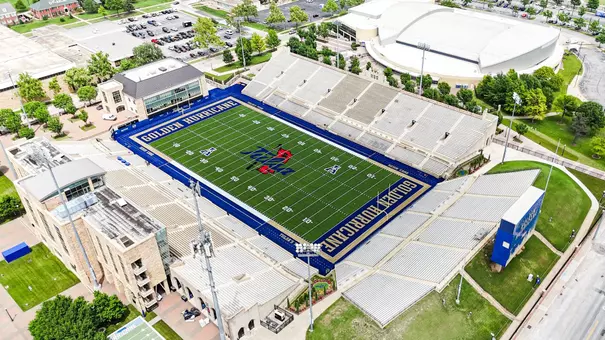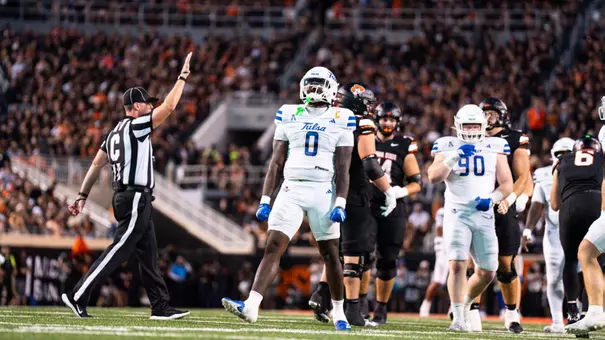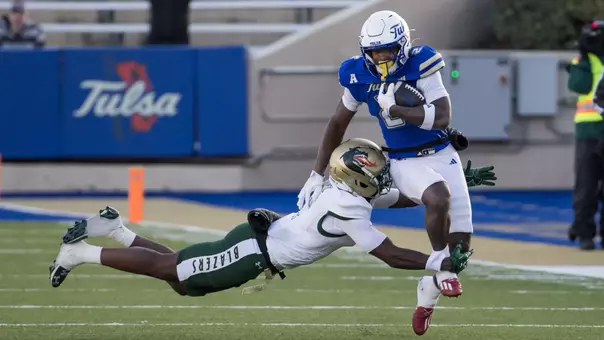
90 Years of H.A. Chapman Stadium
10/28/2020 11:00:00 AM | Football
H.A. Chapman Stadium Celebrating 90 Years
This unprecedented year of 2020 has seen a total of three different home opening dates come and go for the Tulsa football team without playing a game at Skelly Field at H.A. Chapman Stadium.
Now, on October 30, Tulsa will host the East Carolina Pirates in its first home game of this 90th year of Chapman Stadium. Never before in the 90-year history of Chapman Stadium has the Golden Hurricane opened its home schedule later than this season.
The stadium first opened in 1930 as Skelly Field, later was named Skelly Stadium and in April 2007 received the name of H.A. Chapman Stadium. The stadium underwent a major facelift in the summer of 2008 and on September 20, 2008, Tulsa opened the renovated stadium with a 56-14 victory over the New Mexico Lobos.

In the opening game 90 years ago, Tulsa opened the season at the newly built Skelly Field on Oct. 4 against the Arkansas Razorbacks, and defeated the Hogs by a score of 26-6, the first of six straight wins at Skelly Stadium that year.
Since that day, many tremendous individual moments, terrific games and great plays have taken place, while many outstanding players and coaches have graced Skelly Field at H.A. Chapman Stadium.
Below, we look at H.A. Chapman Stadium by decade and some of the other highlights of the stadium through the years . . .
H.A. Chapman Stadium by Decade . . .
1930s
Oil man and longtime friend of The University of Tulsa, William Skelly, gave $125,000 to the Stadium Fund Drive in the spring of 1930. The remaining $175,000 was raised by Tulsa businessmen who organized the Stadium Corporation of Tulsa. Ground-breaking ceremonies were held on May 11 and the season kicked off on October 4, as Tulsa hosted Arkansas in front of a crowd of 13,000. On the opening kickoff, Arkansas fumbled the ball and Johnny Potts recovered for Tulsa. Billy Boehm scored on the very next play for the first touchdown in the north end of the stadium. Chet Benefiel scored the first TD in the south end zone and Tulsa went on for a 26-6 victory. The Golden Hurricane won its first six games at the new stadium that year.
1940s
A couple years earlier, 1938, the University traded Skelly Field to the Tulsa Public Schools for the Philtower Building lot at 5th and Boston. TU then began to lease the stadium from the board of education. In the 1940s, Skelly Field was home to some of the best teams in school history. The Hurricane became the first school to play in five straight New Year's Day Bowl Games and the 1942 team posted a 10-1 record and finished the season ranked fourth in the final Associated Press poll. In 1947, William Skelly turned the first shovel full of dirt at ground-breaking ceremonies for a 5,000-seat north end zone expansion and the name changed to Skelly Stadium. The first home game that season saw Tulsa defeat West Texas State 26-13 on September 20.

1950s
The 1950s began with Tulsa going undefeated at Skelly Stadium in the decades first three seasons, posting an 18-0-2 record covering 1950 through 1952. In 1956, a Billy Graham rally brought a crowd of 28,000 on June 18, 1956.
1960s
The Stadium Corporation was reorganized in 1964 and planned to build two high school stadiums (LaFortune and McLain) in exchange for Skelly Stadium. Skelly would be enlarged to 40,235 seats and the total program would cost $1,250,000. The track was removed, the field lowered and box seats added. The excavated dirt was used to support the new south end zone stands. Seating was added to the west stands plus a new two-story press box, escalator and elevator. The third story photo deck was added the next year. Skelly Stadium was returned to become the property of TU in 1968.
1970s
The 1970s saw numerous players who went on to NFL careers grace the Skelly Stadium turf that decade, including NFL legends Steve Largent and Drew Pearson. The grass field was changed to Tartan Turf in the summer of 1972. Professional soccer made its debut at Skelly Stadium with a preseason game in 1977, and a year later the Tulsa Roughnecks made Skelly Stadium its home. Tulsa won its 200th game at Skelly Stadium on September 15, 1979 with a 28-20 win over Southwestern Louisiana.

1980s
In the spring of 1980, a modern scoreboard and animated message center was installed above the south stands. John Cooper's 1980 team ushered in the new decade with an 8-3 record, including a 5-0 mark in home games. Tulsa's 10-1 record in 1982, including a 5-0 home record, was the fourth 10-win season in school history and just the second since Skelly Stadium was built.
1990s
Some of the biggest wins in Skelly Stadium history came in the 1990s. The Miracle on 11th Street was just the start on September 21, 1991, when the Hurricane came back from a 24-10 halftime deficit for a thrilling 35-34 victory over #15-ranked Texas A&M. In 1996, Tulsa opened its home season with a 27-20 win over #19 Iowa and two weeks later defeated Colorado State, 20-14, in its debut game of the Western Athletic Conference.
2000s
The 2000s began with the installation of a new FieldTurf, a synthetic artificial turf that looked and felt like natural grass. The north end zone stands were demolished in 2005 to make room for the new Case Athletic Complex that opened in 2007. It was also announced in 2007, that Skelly Stadium would have a new name – H.A. Chapman Stadium and in 2008 the stadium went through a complete renovation. The renovated stadium opened on September 20 with a 56-14 victory over New Mexico.

opens the season.
2010s
Three 10-win seasons came in this decade with the first coming in 2010 at 10-3. In 2012, Tulsa posted an 11-3 record and won the Conference USA Championship on its home turf with a 33-27 overtime win over UCF. Tulsa also claimed a 10-3 record in the 2016 season.
H.A. Chapman Stadium Highlights . . .
1930 — Groundbreaking ceremony for the 14,500 seat Skelly Field occurred on May 11. The first football game was played on Oct. 4, 1930 in front of a crowd of 13,000. Tulsa defeated Arkansas 26-6.
1938 — TU traded Skelly Field to the Tulsa Public Schools for the Philtower Building lot at 5th and Boston. TU began to lease the stadium from the board of education.
1947 — Lease renewal for Skelly Field was signed. The 5,000-seat north end zone section was added and the scoreboard moved to the south end zone. Skelly Field was the original name but changed to Skelly Stadium when the north end zone seats were added.
1953 — In August, former TU star Jim Finks played for the Pittsburgh Steelers in an exhibition game against the Chicago Bears before a crowd of 10,000.
1956 — On June 18, Evangelist Reverend Billy Graham held a one-night rally and set what was to that date a stadium record crowd of 28,000.
1960 — Newly formed American Football League entries, Houston Oilers and Dallas Texans, met in an exhibition contest in August.
1964 — The stadium corporation was re-organized and it planned to build two high school stadiums (LaFortune and McLain) in exchange for Skelly Stadium.

1965 — Skelly Stadium was enlarged to 40,235 seats at a cost of $1,250,000. The track was removed, the field lowered and box seats added. The excavated dirt was used to support the new south end zone stands. Seating was added to the west stands plus a new two-story press box, escalator and elevator. Work was completed in August.
1966 — The third story photo deck was added to the press box. Skelly Stadium turned into a baseball field for one game on May 5. The St. Louis Cardinals baseball club played their triple-A farm team, the Tulsa Oilers, in an exhibition game. The contest drew a crowd of 18,904, which saw the Cards beat Tulsa 5-4.
1968 — Skelly Stadium was returned to the University.
1972 — Tartan turf was installed in the summer months.
1977 — Professional soccer made its debut at Skelly Stadium with a preseason game.
1978 — The Tulsa Roughnecks, an NASL professional soccer team, moved into Skelly Stadium.
1979 — Getty Oil Company and Getty Refining and Marketing Company made a $350,000 grant for refurbishing and repairs to the Stadium.
1980 — A modern scoreboard and animated message center was installed above the south stands. The sign package was donated by Dr. Pepper, KJRH Television and Getty Refining and Marketing Company. The largest crowd for soccer occurred on April 26 when the Roughnecks met the New York Cosmos before 30,831 fans.
1987 — The largest crowd in Skelly Stadium history, 47,350, saw Tulsa lose to the nation's number one-ranked Oklahoma Sooners, 65-0.

1982 — A new artificial turf was installed and the lighting system was replaced.
1984 — A new scoreboard above the north end zone and 25-second clocks were added in each end zone.
1991 — Stadia Turf, a new artificial surface, was installed in the summer. The football season had the highest season attendance average in school history with an average of 31,236 fans for seven home games.
1993 — A new scoreboard was erected in the south end zone. It was completed just one day before the home opener on September 18.
2000 — New FieldTurf was installed in the summer. The synthetic artificial turf looks and feels like natural grass. The visiting team locker room was refurbished. 2003 — Installed new stadium lighting.
2005 — The north end zone stands were demolished in February, thus clearing way for the new Case Athletic Complex. The stadium seating was reduced from 40,385 to 35,542.

before renovation begins after 2007 season.
2007 — The Case Athletic Complex in the north end zone was completed in June; and on April 24, it was announced that the H.A. and Mary K. Chapman Trust has provided the financial gift for half of the estimated cost for renovation of the newly named H.A. Chapman Stadium.
2008 — The H.A Chapman Stadium underwent major renovation and now has a new stadium capacity of 30,000.
2013 — A new playing surface, FieldTurf Revolution Cool Play featuring cork and rubber, was installed in the spring of 2013, as was an 80-foot LED electronic sign located on the south end zone field level wall.
2017 — A new FieldTurf surface was installed.
2018 — ONEOK Club had a complete renovation and an LED board was installed to the north end zone.
FB | UAB Preview
Monday, November 24
FB | Tre Lamb Army Preview
Monday, November 17
FB | Tre Lamb Oregon State Preview
Monday, November 10
FB | Tre Lamb FAU Preview
Monday, November 03
























